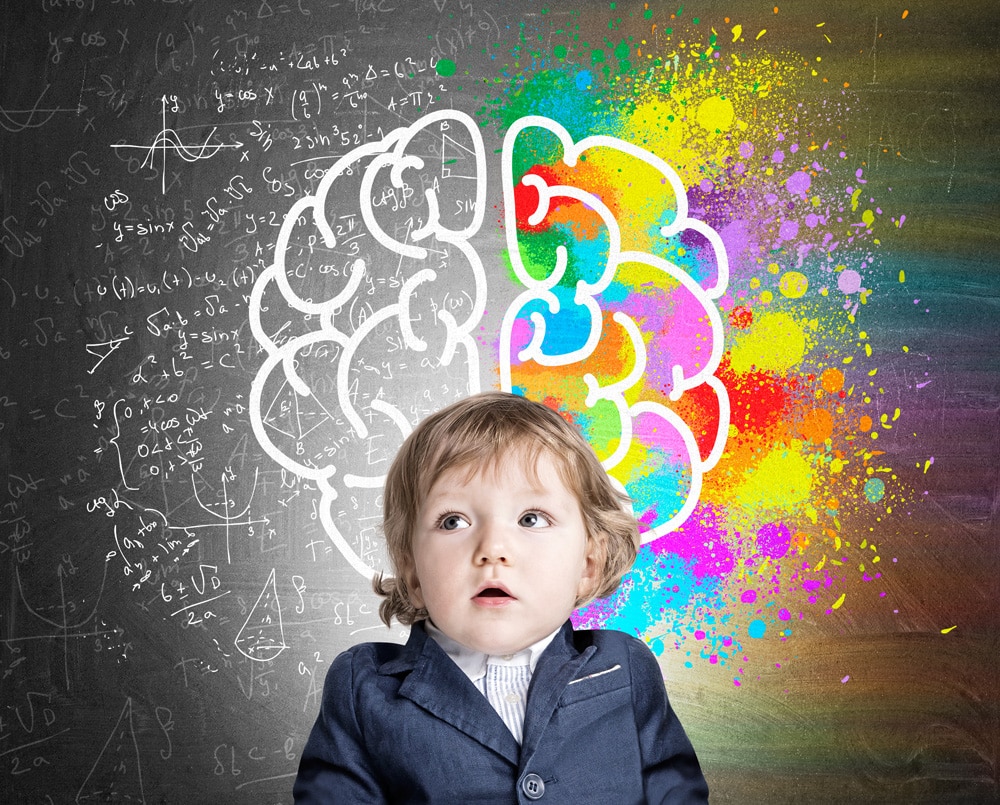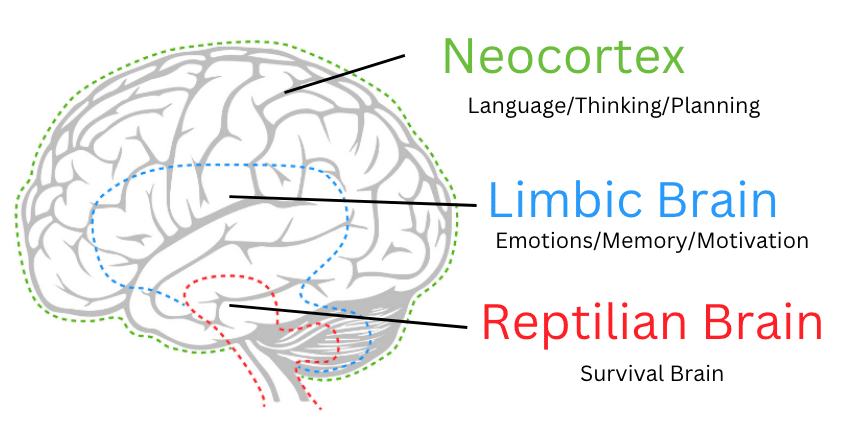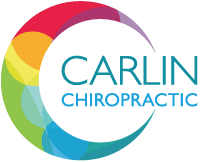
The human brain’s processes are organised in the form of a pyramid. The higher order thinking functions such as reading, algebra and empathy depend on the established development of previously evolved brain functions, such as the ability to engage in basic bodily functions including breathing, moving, responding to our senses and assessing for danger. Below we discuss the 3 Brain Pyramid Model, including the Reptilian Brain, Limbic Brain and Neocortex.
The 3 Brain Pyramid Model
The Reptilian Brain
The Reptilian Brain is the oldest part of the brain and is the automatic, instinctive part of the brain which consists of the brainstem and cerebellum. It is located at the base of the skull and oversees all human functions we do not have “conscious control over”. This is the first part of the brain to develop in the womb and is in control of our blood pressure, heartbeat and breathing rate and is responsible for our ability to swallow, sneeze and laugh(1). This part of the brain is all about ‘me’ and my survival – safety, food, shelter and reproduction.
The reptilian brain receives the sensory information from the body (touch, taste, hearing and seeing) and receives information about where our heads, bodies and limbs are in space. The brainstem monitors our world and sends on the information to the higher centres in the brain for interpretation and decision making. The primitive reflexes (the autonomic movement patterns that commence during pregnancy ensure our survival as a baby) come from the reptilian brain. This is the main area we ‘live’ in for the first 15-18 months(1).

The Limbic Brain
The Limbic brain Is the next brain area to develop. Here we start taking control of our world through voluntary movements in gravity and postural reflexes(1). We intentionally reach out for things, we learn to roll, walk and jump. The primitive reflexes get integrated into postural reflex as the limbic brain begins to develop. The postural reflexes are subconscious movements which ensure we are centred the ‘right way up’ and help us protect from injury if we are off centre. Our postural reflexes and our voluntary control of movement start developing within the first few months of our life(2).
It is also the part of the brain where we start to understand our emotions and the power of them and where we determine the strength of our stress response. Overall, this part of the brain is involved in most of the ‘typical’ trauma response. Developmentally we ‘live’ in the Limbic brain from about 15 months to about 4 years of age.

The Neocortex
The Neocortex is the third layer to the pyramid and is the most recent evolutionary addition to the brain. It makes up 25% of the total brain volume and contains 85% of the neurons(3). The Neocortex is the command centre. It reads all our senses, allows us to form complex memories, interpret sound and visual images and to reason and to solve problems. This is where our formal learning takes place, where we attain language, recognize symbols (letters/numbers), make decisions as well as feel empathy, analyse information and decide what is right from wrong.
The Neocortex is made up of the left and right hemispheres. To encourage both hemispheres to communicate well, they must be strongly connected by the midline. This connection develops early on when your baby starts to use both sides of their body simultaneously. For example, when your baby reaches for an item, crosses their midline with their hands and feet and begins to cross-crawl. We live in the neocortex from the age of 4 years old onwards(4).
Subluxation and how it occurs in Children
Chiropractic is based on the assessment and correction of interference in the communication between the brain and the body – this is termed vertebral subluxation. A subluxation is a dysfunction in a joint or motion segment where alignment, movement and physiological function is altered which may lead to pain, inflammation and dysfunction. This will also change the input being sent to the brain and processed resulting in altered perception and output, thus changing the trajectory a child moves through this hierarchy of development(2).
If increased demand (physical, chemical, or emotional stress) is placed on a child in a size that the child is unable to meet, a response or adaptive change can happen in the body. Subluxation is a failure of adaptation that can be a result of demand exceeding the ability to process or meet demand. This subluxation can result in an increased stress response and an altered afferent input to the brain from the body4. When this occurs during a child’s early life, the mapping of the developing brain can change in a way that changes the movement through the developmental path.

Treating Subluxation with Chiropractic Care
Recent studies have shown that subluxation-based Chiropractic Care improves sensorimotor filtering, cortical and cerebellar motor processing, and multisensory processing, all of which may be important in neurodevelopment(1). If Chiropractic Care can improve these things, then understandably subluxation is altering these developmental functions.
Our next blog post will cover what happens if a vertebral subluxation is not resolved and research into improved brain development in children undergoing Chiropractic Care for correction of vertebral subluxation.
Learn more about the 3 Brain Pyramid Model and Treating Subluxation
If you haven’t already attended one of our complimentary ‘Pre-care Workshops’ to learn more about the 3 Brain Pyramid Model and treating subluxation, please enquire with your Chiropractor or our lovely front desk girls. Reach out to us today.
1 Bladt, D. (2016). Switched-on kids. Australia: Family Chiropractic Centre.
2 Morningstar, M. W., Pettibon, B. R., Schlappi, H., Schlappi, M., & Ireland, T. V. (2005). Reflex control of the spine and posture: A review of the literature from a chiropractic perspective. Chiropractic & Osteopathy, 13(1). DOI:10.1186/1746-1340-13-16
3 Rakic, P. (2009). Evolution of the neocortex: A perspective from Developmental Biology. Nature Reviews Neuroscience, 10(10), 724-735. DOI:10.1038/NRN2719
4 Gustafson C. (2017) Bruce Lipton, PhD: The Jump from Cell Culture to Consciousness. Integrative Medicine (Encinitas, Calif.), 16(6), 44-50.
5 Haavik H. Murphy B. The role of spinal manipulation in addressing disordered sensorimotor integration and altered motor control. J Electromyogr Kinesiol. 2012 (Oct); 22(5): 768-76.




